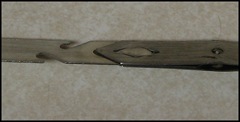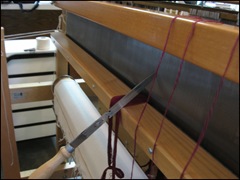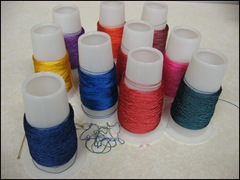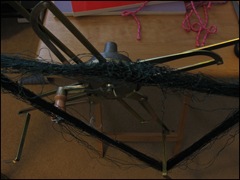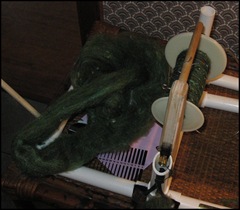I am done winding the cones.
I wish I could say that I had only one awful skein. I wish I could say that after that one awful skein, cone winding went utterly smoothly. T'wasn't so.
ANOTHER SKEIN FROM YOU-KNOW-WHERE
A number did go fairly well, but there were others. One skein in particular gave me terrible grief. Every time I hit a snag (which was constantly) I tried to figure out what the cause was. When I placed my hand under the skein and looked really carefully and moved yarns about, it was clear that yarns were just continuously twisting around each other.
SILK ORGANZINE AND BOMBYX SILK
Thanks to my hunches and to Dot's carefully researched post on silk which confirmed my hunches, I figured it was the nature of the yarn. The organzine is a very tightly twisted yarn which easily plies back on itself and which also engages in excessive twisting with its neighbors.
This twisting (but not the plying back) happens with the 60/2 bombyx silk. It was quite evident as I was doing the preparations for warping the loom and also warping the loom. So if I am not careful in making the skeins of bombyx silk, I will have the same problems i have been having with these skeins of silk organzine.
But I was very careful making these skeins and the snarls and snags still happened!
STRENTH OF SILK ORGANZINE
One interesting difference, back in the days when I didn't know a thing about silk and I had so many problems with snags, the silk also frequently broke under the tension. No breaking with the organzine. Again, Dot's research confirms the strength of the silk organzine.
It is some small comfort that the yarn was not continually breaking.........
CHANGING ENDS
Anyway, I was having so much trouble with this particular skein that I decided to cut the end I was using, attach it to the other end and try it from there. Spinners do that when they have trouble with a roving. Why can't I when I am having trouble winding cones? Also I had done this with an earlier skein and it had seemed to help.
Well, it helped this time too. The rest of the winding the cone went quite smoothly with only the occasional snag.
Is there something to this difference? I really don't think it had anything to do with the smoothness/direction of the yarn as spinning of roving does. But I did notice something interesting.
WHICH END TO UNWIND FROM?
When you make a skein, you tie the beginning of the skein to the end of the skein. When you get ready to make a cone from it, you cut the tied ends and choose one of those ends to unwind from.
I had already figured out that it didn't matter which way the skein winder turned. So there was no reason for choosing one end over the other on that basis. But then I saw another basis for choosing one end over the other.
When I was having so much trouble, I was unwinding from the part of the skein that was farthest away from me and closest to the body of the skeiner. When I changed to the other end, I was unwinding from the part of the skein that was closest to me.
SMOOTH UNWINDING
I had two more skeins to unwind. Each of them I unwound with the end closest to me. In both cases the unwinding went smoothly with only an occasional snag..............
Related Posts:
Winding Cones
That Badly Snarled Skein of Yarn
Preparing the Warp Bouts for the Loom
Twist at Lease Sticks
Winding on the Warp
© 2008


